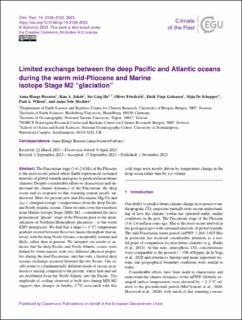| dc.contributor.author | Braaten, Anna Hauge | |
| dc.contributor.author | Jakob, Kim A. | |
| dc.contributor.author | Ho, Sze Ling | |
| dc.contributor.author | Friedrich, Oliver | |
| dc.contributor.author | Galaasen, Eirik Vinje | |
| dc.contributor.author | De Schepper, Stijn | |
| dc.contributor.author | Wilson, Paul | |
| dc.contributor.author | Meckler, Anna Nele | |
| dc.date.accessioned | 2024-01-17T11:55:26Z | |
| dc.date.available | 2024-01-17T11:55:26Z | |
| dc.date.created | 2023-11-01T10:20:02Z | |
| dc.date.issued | 2023 | |
| dc.identifier.issn | 1814-9324 | |
| dc.identifier.uri | https://hdl.handle.net/11250/3112144 | |
| dc.description.abstract | The Piacenzian stage (3.6–2.6 Ma) of the Pliocene is the most recent period where Earth experienced sustained intervals of global warmth analogous to predicted near-future climates. Despite considerable efforts to characterize and understand the climate dynamics of the Piacenzian, the deep ocean and its response to this warming remain poorly understood. Here we present new mid-Piacenzian Mg/Ca and Δ47 (“clumped isotope”) temperatures from the deep Pacific and North Atlantic oceans. These records cover the transition from Marine Isotope Stage (MIS) M2 – considered the most pronounced “glacial” stage of the Pliocene prior to the intensification of Northern Hemisphere glaciation – to the warm KM5 interglacial. We find that a large (> 4 ∘C) temperature gradient existed between these two basins throughout that interval, with the deep North Atlantic considerably warmer and likely saltier than at present. We interpret our results to indicate that the deep Pacific and North Atlantic oceans were bathed by water masses with very different physical properties during the mid-Piacenzian, and that only a limited deep oceanic exchange occurred between the two basins. Our results point to a fundamentally different mode of ocean circulation or mixing compared to the present, where heat and salt are distributed from the North Atlantic into the Pacific. The amplitude of cooling observed at both sites during MIS M2 suggests that changes in benthic δ18O associated with this cold stage were mostly driven by temperature change in the deep ocean rather than by ice volume. | en_US |
| dc.language.iso | eng | en_US |
| dc.publisher | Copernicus Publications | en_US |
| dc.rights | Navngivelse 4.0 Internasjonal | * |
| dc.rights.uri | http://creativecommons.org/licenses/by/4.0/deed.no | * |
| dc.title | Limited exchange between the deep Pacific and Atlantic oceans during the warm mid-Pliocene and Marine Isotope Stage M2 “glaciation” | en_US |
| dc.type | Journal article | en_US |
| dc.type | Peer reviewed | en_US |
| dc.description.version | publishedVersion | en_US |
| dc.rights.holder | Copyright 2023 The Author(s) | en_US |
| cristin.ispublished | true | |
| cristin.fulltext | original | |
| cristin.qualitycode | 1 | |
| dc.identifier.doi | 10.5194/cp-19-2109-2023 | |
| dc.identifier.cristin | 2190909 | |
| dc.source.journal | Climate of the Past | en_US |
| dc.source.pagenumber | 2109–2125 | en_US |
| dc.relation.project | ERC-European Research Council: 638467 | en_US |
| dc.relation.project | Bergens forskningsstiftelse: BFS2015REK01 | en_US |
| dc.relation.project | Deutsche Forschungsgemeinschaft: JA2803/2–1 | en_US |
| dc.relation.project | Deutsche Forschungsgemeinschaft: FR2544/6 | en_US |
| dc.subject.nsi | VDP::Marin geologi: 466 | en_US |
| dc.subject.nsi | VDP::Marine geology: 466 | en_US |
| dc.identifier.citation | Climate of the Past. 2023, 19 (11), 2109–2125. | en_US |
| dc.source.volume | 19 | en_US |
| dc.source.issue | 11 | en_US |

